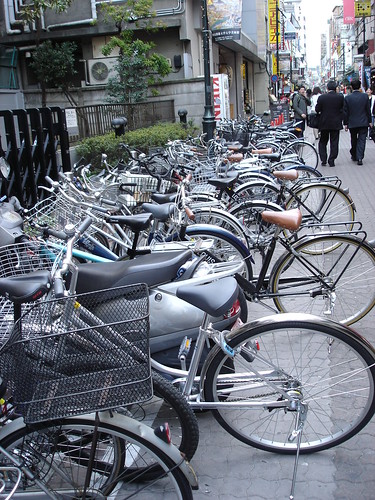After the Great Tohoku Earthquake of March 11 2011 brought transportation to a standstill throughout Japan, tens of thousands of Tokyo residents and workers bought bicycles to get themselves home. Although roads and rail are mostly back to normal in Tokyo, many workers have stuck with pedal powered transport for their daily commute.

From the Asahi Shimbun (English language) – “Have wheels, will travel; especially after a major earthquake”:
“I’ve always known that a bicycle is useful, but I would never have thought of riding to work on one except for the quake,” says one 35-year-old office worker in Tokyo’s Toranomon district. “Now I don’t know why I didn’t do it earlier. The distance from home is a lot closer than I thought.”
While some are motivated by newfound convenience, others say they bike as part of a national effort to save gasoline. 20% of Japan’s refinery capacity remains shutout in the aftermath of the quake and tsunami. Gas prices in Tokyo have leapt ¥30 per liter in the past two weeks. An equivalent jump in California from today’s prices would bring the price at the pump to $5.30 (& 99/100¢) per gallon.
Tokyo safety officials, in the meantime, look at the downside of those extra bicycles on their city streets: ” From a safety point of view, all those new vehicles on the road could become an issue,” says Tokyo public safety official Kazuo Oya. Among his concerns: That bicycles will get in the way of evacuating traffic in the event of another disaster, because evacuation by car worked so well on March 11.
More at the Asahi Shimbun: Have wheels, will travel; especially after a major earthquake. Via Byron Kidd of Tokyo By Bike.
Watch later today for Part 2 of this, in which we look at Tokyo’s response and how this might relate to America’s readiness to large scale disasters.
Photo “Tokyo Bicycles” CC BY-NC 2.0 by Kelly from Sydney.
“From a safety point of view, all those new vehicles on the road could become an issue”
Wow. So apparently the fact that each bicycle represents not a new vehicle on the road, but rather a replacement for a previously much larger vehicle that can’t be picked up and moved off of a crowded road by hand, or ridden down a sidewalk, or across nearly any terrain didn’t occur to this person?
Heh, good point.
But in Tokyo, those bicycles are likely new instead of replacement vehicles. About 80% of commuters use rail transport in Tokyo. For the very dense core of Tokyo, that modal share goes to 90%. Nationwide (and excluding Tokyo, Nagoya and Osaka regions) public transport modal is “only” 20%.
Oh wow! I knew rail was more viable and used, but I didn’t realize it was that much more. That’s incredible.
In N.America a bicycle is a replacement for a car; in Tokyo it is a replacement for standing space in a train. Still, considering how little road space and energy usage a cyclist requires, the complaints of the official are those of your typical entitled automobile user. The eastern half of the main island has something like 70% of its peak power availability, and a similar shortage of gasoline, and foot or bicycle are the only transportation methods that tax neither.
In my blog I wrote about my experience getting home after the quake:
“Even if you can get fuel for your car, you cannot get anywhere in one. On my 12km Tokyo walk home after the quake the outbound roads were jammed with cars, as the sidewalks were with people, but the people on foot could still make 5km/hr, whereas the cars made much less than that. Bicycles did even better, and small motorbikes moved with mixed results, as they cannot get through all the spaces that even a bicycle can. I got home in two and a half hours, whereas my wife’s cousin who did a similar distance as a car passenger took six hours. In addition, one of the reasons we have not left Tokyo is that the 80km trip to Narita airport is no longer an option by car, and an ordeal by train, running at 50% of regular service.”
http://hanlonsrzr.blogspot.com/2011/03/disaster-preparation-transportation.html